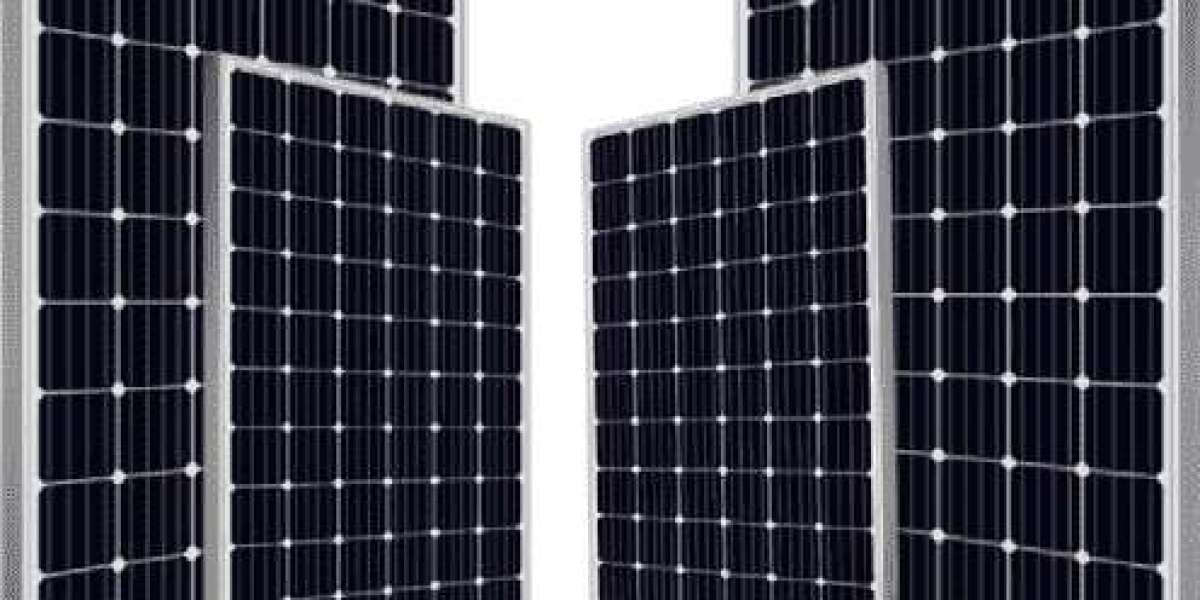These panels are made from a single crystal structure, usually silicon. Monocrystalline solar panels are known for their high efficiency, as the single-crystal structure allows for a more organized flow of electrons. They are space-efficient and have a sleek, black appearance. While they tend to be more expensive, their efficiency often justifies the cost.
What are Monocrystalline Solar Panels?
Monocrystalline solar panels are a type of advanced photovoltaic technology designed to harness solar energy efficiently. These panels are constructed using a single crystal structure of high-purity silicon, typically grown in the form of a cylindrical ingot and then sliced into thin wafers. The singular crystal structure contributes to the high efficiency of monocrystalline solar panels, as it allows for more effective electron flow during the conversion of sunlight into electricity. These panels are renowned for their exceptional performance, delivering a higher energy conversion rate than other solar panels for commercial in india. The sleek, black appearance of monocrystalline panels adds an aesthetic appeal, making them a popular choice for residential and commercial installations. While these panels tend to be more expensive to manufacture, their space efficiency, durability, and long lifespan often make them a preferred option for those seeking optimal energy production and reliability over the long term.
How do Monocrystalline Solar Panels Work?
Monocrystalline solar panels work based on the photovoltaic effect, which is the process of converting sunlight directly into electricity. Here's a simplified explanation of how they work:
- Absorption of Sunlight: Monocrystalline solar panels are made up of individual solar cells, each consisting of a semiconductor material, usually silicon. When sunlight hits the surface of the solar panel, the photons (light particles) are absorbed by the silicon material.
- Generation of Electron-Hole Pairs: The absorbed photons transfer their energy to electrons in the silicon atoms, causing them to become excited and break free from their atomic bonds. This creates electron-hole pairs, where an electron is freed from its position (leaving behind a positive "hole").
- Movement of Electrons: Due to the built-in electric field within the solar cell, the free electrons are forced to move in a particular direction, creating an electric current. This flow of electrons is what we refer to as electricity.
- Collection of Electricity: The electric current generated by the movement of electrons within each solar cell is collected by metal contacts on the top and bottom of the cell. These contacts allow the electricity to be extracted from the solar panel and transferred to an external circuit.
- Conversion to Usable Power: The electricity generated by individual solar cells is typically in direct current (DC) form. In many applications, such as residential or commercial buildings, this DC electricity is then converted into alternating current (AC) using an inverter, which is the type of electricity used in most household appliances and the electrical grid.
Installation and Maintenance of Monocrystalline Solar
Installation and maintenance of monocrystalline solar panels require careful planning and periodic upkeep to ensure optimal performance and longevity. Here's a guide to both processes:
Installation:
- Site Assessment: Before installation, assess the site's solar potential, considering factors such as sunlight exposure, shading, and structural integrity for panel mounting.
- Permitting and Regulations: Obtain necessary permits and comply with local regulations governing solar panel installation. This may involve submitting plans to local authorities and obtaining approvals.
- Mounting System: Choose an appropriate mounting system based on the roof type and orientation. Securely attach mounting hardware to the roof or ground, ensuring proper alignment and spacing to maximize sunlight exposure.
- Electrical Wiring: Install electrical wiring to connect the solar panels for the home in india series or parallel configurations, depending on system requirements. Ensure proper grounding and compliance with electrical codes and safety standards.
- Inverter Installation: Install inverters to convert DC electricity generated by the solar panels into usable AC electricity for household appliances or grid connection. Position inverters in a well-ventilated area away from direct sunlight.
- Connection to Grid or Battery: Connect the solar panel system to the electrical grid or battery storage system, following manufacturer guidelines and safety protocols. Test the system to ensure proper functionality and energy generation.
Maintenance:
- Regular Cleaning: Periodically clean the surface of the solar panels to remove dust, dirt, bird droppings, and other debris that can reduce energy production. Use a soft brush or sponge with water and mild detergent, avoiding abrasive materials that may scratch the panels.
- Inspection: Conduct routine inspections of the solar panel system to check for signs of damage, corrosion, loose connections, or shading from nearby trees or structures. Address any issues promptly to prevent performance degradation.
- Monitoring Performance: Monitor the performance of the solar panel system using monitoring software or devices to track energy production, efficiency, and potential issues. Analyze data regularly to identify trends and optimize system performance.
- Trimming Vegetation: Trim or prune vegetation near the solar panels to prevent shading and maximize sunlight exposure. Maintain a clear space around the panels to minimize obstructions and optimize energy production.
- Professional Maintenance: Schedule periodic professional maintenance inspections by certified technicians to assess system health, clean components, and perform any necessary repairs or upgrades. Follow manufacturer recommendations for maintenance intervals and procedures.
What are the benefits of monocrystalline solar panels?
Monocrystalline solar panels offer several benefits compared to other types of solar panels, making them a popular choice for residential, commercial, and industrial applications. Here are some of the key benefits:
- High Efficiency: Monocrystalline solar panels are among the most efficient types of solar panels available. Their single-crystal structure allows for better electron flow, resulting in higher energy conversion rates and greater electricity production per square meter of panel area.
- Space Efficiency: Due to their high efficiency, monocrystalline solar panels require less space to generate the same amount of electricity compared to other types of solar panels. This makes them ideal for installations with limited roof space or where maximizing energy production is essential.
- Longevity: Monocrystalline solar panels are known for their durability and long lifespan. They are designed to withstand harsh weather conditions, such as heavy rain, snow, and wind, and typically come with warranties lasting 25 years or more.
- Aesthetic Appeal: Monocrystalline solar panels often have a uniform black color, which many homeowners find aesthetically pleasing. Their sleek appearance can enhance the overall look of a building or property where they are installed.
- Low Light Performance: Monocrystalline panels perform well even in low-light conditions, such as cloudy days or early mornings and late afternoons. This ensures continuous energy production throughout the day and in locations with variable weather patterns.
- Minimal Maintenance: Once installed, monocrystalline solar panels require minimal maintenance. Routine cleaning and occasional inspections are typically sufficient to keep them operating at peak performance.
- Environmental Benefits: Monocrystalline solar panels produce clean, renewable energy without emitting greenhouse gases or pollutants. By harnessing solar power, they contribute to reducing carbon emissions and mitigating climate change.
- Versatility: Monocrystalline solar panels can be used in various applications, including residential, commercial, and industrial settings. They can be installed on rooftops, ground mounts, or integrated into building facades and structures.
What is the price of a monocrystalline solar panel?
The price of monocrystalline solar panels can vary depending on several factors, including the manufacturer, quality, efficiency, size, and location. As of my last update here are some general price ranges you might expect for monocrystalline solar panels:
- Residential Panels: For residential installations, monocrystalline solar panels typically cost between INR 20-30 per watt. This means that a 300-watt monocrystalline solar panel could cost anywhere from INR 8000-9000.
- Commercial Panels: Commercial-grade monocrystalline solar panels may be priced slightly lower per watt compared to residential panels, often ranging from 20-25 per watt.
- High-Efficiency Panels: High-efficiency monocrystalline solar panels, which can generate more electricity in less space, tend to be more expensive. Prices for high-efficiency panels can range from INR 35-40 per watt or more.
Conclusion - Monocrystalline solar panels stand out as a leading technology in the solar energy industry, offering numerous advantages that make them a popular choice for residential, commercial, and industrial applications. With their high efficiency, space efficiency, durability, aesthetic appeal, and environmental benefits, monocrystalline solar panels provide a cost-effective and sustainable solution for generating clean electricity from the sun. While initial costs may be higher compared to other types of solar panels, the long-term energy savings, reliability, and longevity of monocrystalline panels make them a smart investment for those seeking to reduce their carbon footprint, lower energy bills, and contribute to a greener future.



